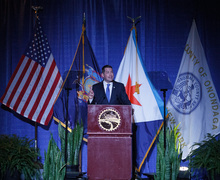Sydor: Weekend trip spent exploring ancient city Petra by camel, camping outdoors
As I walked down a winding canyon trail, I was blown away when I saw the stone carvings peeking around the next corner. The iconic pillars and buildings carved into a stone at Petra was a sight I will never forget.
The amazing architectural achievement on display was like nothing I had ever seen before. The buildings dated back to Roman times, yet the precision would challenge masons today.
My program went on a three-day trip to the most famous attraction in Jordan. Petra was built by the Nabataeans, who lived in Jordan during the Roman era. It was the capital of the empire, a prosperous city for hundreds of years that was annexed by the Romans in 106 A.D.
After seeing the inspiring view of the “treasury” — the famous building at the end of the canyon trail — I traveled to the next set of buildings by camel, the ancient — albeit awkward — animals known in Arabic as “safinat al sahara,” which means “ship of the desert.”
Actually, despite its awkwardness, the camel was fun to ride, perhaps an even smoother ride than a horse.
After the camel journey, we arrived at the head of a colonnaded street that ran through the center of the old Nabataean capital. As is usual in Jordan, I could climb over the ruins and touch the ancient stones, carved more than two millennia ago.
We were also lucky to meet up with a local archaeologist who was in the middle of a restoration project on one of the Nabataean temples. His project is particularly interesting because he uses local Jordanian men and women to help reconstruct of the Temple of the Winged Lion so that even after his team of mostly Western archeologists leave, local Jordanians will be able to take care of it.
We saw many old buildings, houses and graves dug into the side of the cliffs, preserved when they were first built thousands of years ago.
Unfortunately, we only had time to stay in Petra for one day, although I easily could have spent more time there exploring its many secrets. But we had to get to our next stop at Wadi Rum in Southern Jordan.
Wadi Rum, along with Petra, is one of four World Heritage sites in Jordan, meaning they are recognized by the United Nations as having “cultural or natural importance to humanity.”
Wadi Rum is special because it is a desert valley that is cut into sandstone and limestone in Southern Jordan, and the park itself is about 1 percent of the entire country of Jordan. It has been continuously inhabited by Bedouins for thousands of years and contains traces of their past communities.
We drove jeeps through the desert and climbed on the huge mountains that make up the park. There were breathtaking views that allowed you to look for miles across the valley.
That night, we camped out with some Bedouins. They made us dinner and allowed us to sleep in their tents. We sat on the floor with long tables in front of us and ate a delicious meal that the Bedouins had cooked under the sand in a pit filled with coals.
After dinner, we sat around singing and dancing to Bedouin songs with our new friends in the middle of the silent desert.
My friend Alex and I explored the surrounding desert environment and stumbled upon a rock outcropping with a view that revealed the tranquility of the moonlit desert canyon below.
This trip to Petra and Wadi Rum was possibly the best I have ever been on. It’s not hard to see why the Bedouins, despite being surrounded by modern technology that many of their neighbors enjoy, refuse to leave the desert.
Stephen Sydor is a junior international relations major. His column appears every week in Pulp. He can be reached at srsydor@syr.edu.
Published on April 23, 2013 at 1:11 am





